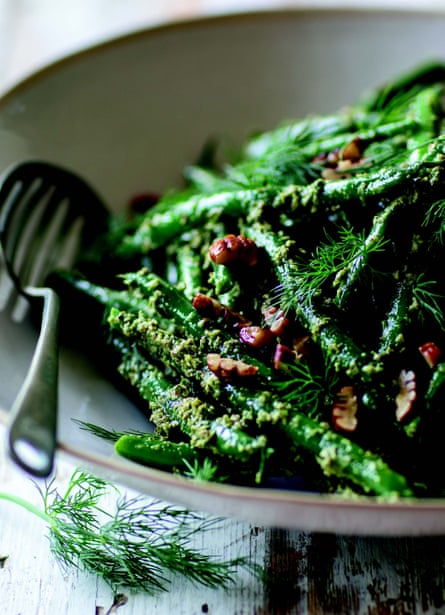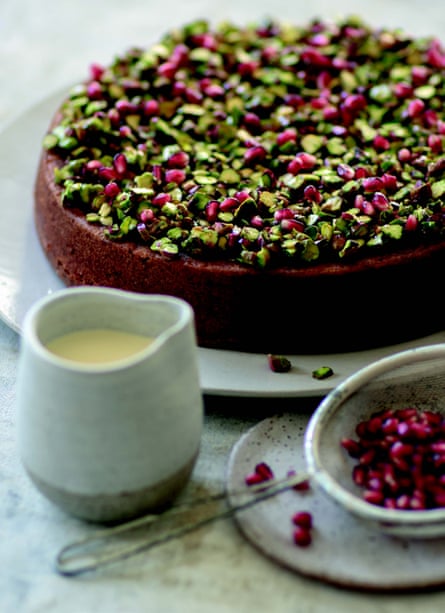
Roasted chicken thighs with lemon, smoked paprika and green olives
I love this simple chicken dish and cook variations of it all the time as it’s such a successful way to cook chicken pieces, and the resulting smoky, lemony cooking juices are delicious. Just make sure everybody gets some of the roasted garlic cloves to squeeze on to their serving of chicken.
The recipe doubles well if you want to serve a large group. However, if you do so, spread the chicken pieces on two trays so they have enough space for the skin to brown and crisp.
Marinade (overnight)
Serves six
8 skin-on chicken thigh cutlets (bone-in)
1 large lemon, sliced into 5mm thick rounds
2–3 whole heads garlic, halved crosswise
18 Sicilian green olives
Thyme sprigs or fresh bay leaf sprigs, to garnish
For the chicken marinade
100ml extra-virgin olive oil
2 large cloves garlic, finely chopped
Zest of 1 large lemon, finely grated
60ml lemon juice
3 bay leaves
1 tbsp thyme leaves, roughly chopped
1 tbsp smoked paprika
2 tsp teaspoons sea salt flakes
Freshly ground black pepper, to taste
In a large bowl, combine the chicken marinade ingredients and thoroughly mix together. Add the chicken cutlets, lemon slices and garlic, then swish them about so they’re well coated in the marinade. (It’s a good idea to slip on a pair of prep gloves and do this with your hands.)
Line a container that will hold the chicken mixture comfortably with a compostable plastic bag. Scrape the mixture into the bag, then knot the bag tightly. Seal the container and pop it in the fridge for at least five hours or preferably overnight – give the bag a good squish occasionally. (The longer you leave the chicken, the more imbued it will become with the flavours. That said, I’ve made this and cooked it almost straight away, and it has still been delicious).
When you’re ready to cook the chicken, preheat your oven to 190C.
Line a large, shallow baking tray with foil, then baking paper. Empty the chicken mixture on to the tray. Arrange the chicken cutlets in a single layer, skin-side up, and tuck the garlic halves and lemon slices around them. (If you want to sit a slice of lemon on each piece of chicken, do – it looks lovely once it’s cooked). Pop the tray in the oven and roast the chicken for about 40 minutes, until it’s deep brown and cooked through but tender. Add the olives in the last five minutes of cooking.
Remove the baking tray from the oven and transfer everything, including any juices, to a large serving platter. Garnish with thyme or bay leaf sprigs to serve.
Green beans in dill and pecan dressing
I taught this recipe in my very first cooking class over 30 years ago, and people still come up to me and say how much they love it. The beans are fragrant with the dill and have a lovely crunch from the pecans. They go beautifully with roast chicken or barbecued fish, but quite often I’ll just turn them into a simple lunch by adding some sliced bocconcini and tomatoes and serving with good bread. You could swap walnuts for pecans if you like, but I do feel the pecans give the dressing a mellower, rounder flavour.
Serves six
750g young green beans, stalks trimmed, tips left on
Dill sprigs, to garnish (optional)
Handful pecans, roasted and sliced, to garnish (optional)
For the dressing
100g spring onions, chopped (can be substituted with chives)
Large handful flat-leaf parsley, chopped
Large handful dill, chopped
1½ tbsp white wine vinegar
120g pecans, lightly roasted
1½ tsp sea salt flakes, or more to taste
Coarsely ground black pepper, to taste
180–250ml extra-virgin olive oil
In a medium-sized pot, cook the green beans in rapidly boiling salted water until just tender, with the slightest bit of crunch. (The best way to check is to scoop one out and bite it.) Drain the beans, and immediately plunge them in a bowl of iced water to set their colour. Allow to cool, then drain, pat dry with a paper towel or clean tea towel, and set aside.
For the dressing: place the spring onion, parsley, dill, vinegar, pecans, salt, pepper and 80ml of the oil in a blender or food processor, and whiz all together. With the motor running, slowly drizzle in more oil until the mixture is smooth and thick. Taste, adjust seasoning and vinegar to taste.
To assemble: place the green beans in a serving bowl and pour over the dressing (you may not need it all). Combine so the beans are well-coated in the dressing. They can be served immediately at room temperature, or chilled.
They look lovely in a shallow bowl scattered with dill sprigs and a handful of roasted pecan slices. The beans still taste terrific the next day, but they lose their vivid colour due to the vinegar in the dressing. If you don’t use all the dressing, store leftovers in a tightly sealed jar in the fridge; the colour will fade over time, but it still tastes great for at least five days.
Pistachio and lime syrup cake with pomegranate seeds

The recipe for this lovely cake was given to me by the wonderful food writer and cooking teacher Elise Pascoe, and I have made it time and again since she passed it on to me. The original version was made with lemons; however, as our lime trees are such bountiful providers for so much of the year I tend to make it with limes instead. It’s a gorgeous, simple cake: light, tangy and eye-catching with its mantel of pistachios and pale-green hue. In season, translucent beads of pomegranate look extraordinarily beautiful scattered over the cake.
A note about the pistachios for this cake: to grind them, I pulse them in the food processor with a tablespoon of flour from the recipe, as the flour helps prevent them becoming oily and forming a paste. Nonetheless, you do have to be watchful as they can go from being perfectly chopped to pasty in the blink of an eye.
Serves six to eight
60g plain flour
1 tsp baking powder
100g pistachios, finely ground
Zest of 3 large limes, finely grated
120g almond meal
250g unsalted butter, at room temperature
200g caster sugar
4 × 60g eggs, at room temperature
80g pomegranate seeds, to decorate (optional, see below)
Rich cream or thick Greek-style yoghurt, to serve
For the syrup and topping
90g caster sugar
125ml fresh lime juice (from about 3 large limes), strained
90g pistachios, roughly chopped
Preheat your oven to 170C. Butter a 22–24cm round cake tin, line the base with buttered baking paper, then dust the tin with flour.
In a medium-sized bowl, add the flour, baking powder, ground pistachios, lime zest and almond meal. Whisk with a balloon whisk for a minute or so, then set the bowl aside.
Place the butter and sugar into the bowl of an electric mixer (or use a hand-held electric beater) and beat on medium speed for about four minutes, stopping and scraping down the sides occasionally, until the mixture looks creamy. Beat in the eggs, one at a time, allowing each egg to be incorporated before adding the next. (Don’t worry if the mixture looks a little curdled after adding the last egg – it will come together again when you add the dry ingredients.) Add the flour mixture and beat on low speed until just combined – be careful not to over-mix, or the cake may be a tough. Scrape the batter into the prepared tin and smooth the top.
Bake the cake for 45 to 50 minutes, or until it springs back when lightly pressed in the centre and a fine skewer inserted in the middle comes out clean. Transfer to a wire rack and leave to cool a little in the tin.
When the cake is lukewarm, make the syrup: place the sugar and lime juice in a small saucepan over low heat and stir until the sugar dissolves. Add the chopped pistachios, bring the mixture to the boil, then remove from the heat.
Turn the cake out on to a serving plate and peel away the baking paper. Slowly spoon the hot pistachio and lime syrup evenly over the top, then leave the cake to cool completely.
Just before serving, scatter with pomegranate seeds (if using). Serve with softly whipped cream or yoghurt.
How to seed pomegranates
This is invariably a messy job, and I find I need to be swathed in my largest apron to avoid getting crimson splashes all over my clothes.

There are a number of ways to tackle it but the easiest way I know is to cut the fruit in half, then use your hands to break it into three or four pieces. Fill a large bowl with cool water, submerge each piece of pomegranate under the water and use your fingers to work the seeds out of the membranes. The seeds will drop to the bottom of the bowl and the bits of membrane will float on the surface. Then all you need do is drain off the water, pat the seeds dry in a tea towel and they’re ready to go.
-
This is an edited extract from In Belinda’s Kitchen: Essential Recipes by Belinda Jeffery, food photography by Rodney Weidland, illustrations by Daniel New. Available now from Simon & Schuster (RRP $49.99).



